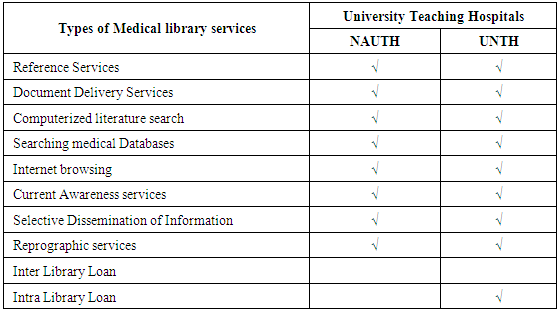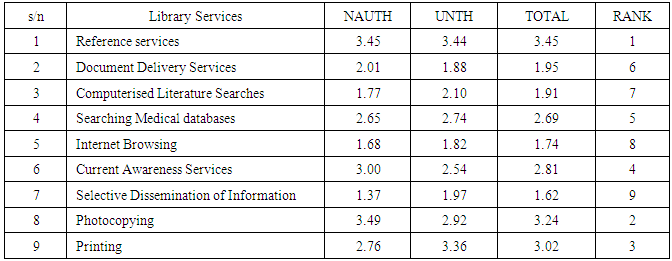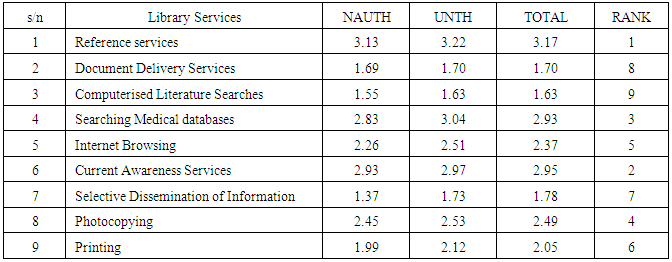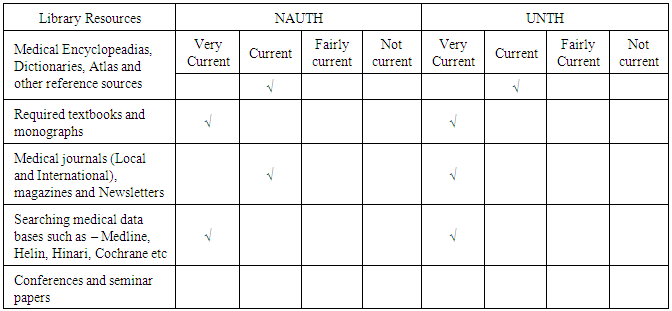-
Paper Information
- Next Paper
- Paper Submission
-
Journal Information
- About This Journal
- Editorial Board
- Current Issue
- Archive
- Author Guidelines
- Contact Us
International Journal of Library Science
p-ISSN: 2168-488X e-ISSN: 2168-4901
2016; 5(1): 1-6
doi:10.5923/j.library.20160501.01

Assessment of Availabile Resources and Library Services Provided in Two Medical Libraries in South-East Nigeria
Umenwa Ekene 1, Amaoge Dorathy Agbo 2, Nnamdi Emmanuel Onyekweodiri 3
1The Medical Library, Federal Neuropsychiatric Hospital Enugu, Nigeria
2Department of Library and Information Science, Michael Okpara University of Agriculture, Umuahia, Nigeria
3University Library, Michael Okpara University of Agriculture, Umuahia, Nigeria
Correspondence to: Amaoge Dorathy Agbo , Department of Library and Information Science, Michael Okpara University of Agriculture, Umuahia, Nigeria.
| Email: |  |
Copyright © 2016 Scientific & Academic Publishing. All Rights Reserved.
This work is licensed under the Creative Commons Attribution International License (CC BY).
http://creativecommons.org/licenses/by/4.0/

This study assessed the available library resources and services provided in two medical libraries in South-east Nigeria. It sought to determine the type of medical library services provided in the two selected libraries, ascertain the extent of availability and the level of adequacy of the available resources. A descriptive survey design was used for the study with a population of 1089 undergraduate students. Sample size of 217 (20%) of the population was used for the study. The instrument for data collection was structured questionnaire and observation checklist. Percentages, mean scores and frequency tables were used in analyzing the data. The findings revealed that the medical libraries under study provided the services listed by the researcher but not without some hindrances as has been observed from the other tables showing the responses of users, not all of them are adequate even though they are available. The findings show that reference services, searching medical databases, Current Awareness Services are rated by the respondents to be the most adequate of all the services listed. Conclusion and recommendations were made based on the findings of the study.
Keywords: Medical Libraries, Library Resources, Library Services
Cite this paper: Umenwa Ekene , Amaoge Dorathy Agbo , Nnamdi Emmanuel Onyekweodiri , Assessment of Availabile Resources and Library Services Provided in Two Medical Libraries in South-East Nigeria, International Journal of Library Science, Vol. 5 No. 1, 2016, pp. 1-6. doi: 10.5923/j.library.20160501.01.
Article Outline
1. Introduction
- Medical libraries are considered as special libraries, as their clientele and services are directed towards specific community and subject respectively. They are also called special libraries because of the specific resources they house i.e. health information resources. Mabawonku (1998) defined health information as those facts, materials or news communicated to people , which help them in the attainment of complete physical, mental and social well being. Saying this, the medical library is a sine qua non in any medical institution as it provides the health information needs of the user community. It should therefore be able to filter information from the available maze of information, package them for effective use and as such become for the users, a source of rapid access for the retrieval and transfer of information and a focal centre which emphasizes the importance of information and knowledge towards the resolution of human health needs (Anyaoku, 2008).To assess, in general, is to determine the importance, size, or value of; to evaluate. Library staff assesses operations by collecting, interpreting, and using data to make decisions and to improve customer service. They study internal processes, levels and quality of service, and library impact on institutional goals (Wright and white, 2007). In the medical libraries, assessment is taking place at all levels in the medical librarianship, (Holtz, 1993) opines that administrators are concerned with issues such as demonstrating the effective use of scarce resources to meet user needs and meet institutional expectations. De Genaro (1984) predicted that there is need to evaluate medical libraries, because in no distant time, the excellence and usefulness of a library will be measured not only by the state and quality of its collections but also by the range of services that its staff are able to deliver to users by conventional and electronic means from a growing variety of services. Users will no longer ask what a library has, but what services it can provide. The impetus to evaluate came from the need to justify budgets more explicitly than ever before (Wilson, 2010). All service functions in all organization are being reviewed in terms of their necessity for the aims of the organization and libraries and information systems are no exception especially in the midst of budget cuts. Palmour (1980) noted that continuous assessment of library services helps the library administrators to check how well the library fits into the organization it is serving, how it serves the current users, and whether there are new audience to recruit and introduce to what the library has to offer, above all it helps the possibility of determining whether and where there is room for improved or additional programmes and services in the future. According to Hernon and McClure (1990) the essence of measurement and evaluation is constantly to question the, study, and improve the effectiveness of library information services and operations. They continued by saying that evaluation embraces change and encourages libraries to treat change as a positive force; by so doing, the librarians will be better positioned to meet the future with effective, efficient services that will play an important and positive role in the information society.
2. Objective of the Study
- The broad aim of the study is to examine the availability of resources and library services provided in two medical libraries in south-east Nigeria. The specific objectives are to: 1. Determine the type of medical library services provided in the two medical libraries.2. Ascertain the extent of availability of the medical library services and resources provided in the medical libraries.3. Determine the level of adequacy of the resources and services in terms of currency, quantity and quality.
3. Scope and Limitations
- The scope of the study encompasses the assessment of availability of resources and library services provided in two medical libraries in south-east Nigeria. However the study has following limitations.(a) The study is limited to Augustine Nnamani Medical library and the medical library at Nnamdi Azikiwe University Teaching Hospital.(b) The study includes only the library users of the two medical libraries.(c) The study is limited to issues militating against the effective provision of medical library services.
4. Review of Related Literature
- Apparently, assessment of medical library services is pertinent to the growth of the library and its parent organization, but the question of what to assess arises. Wilson (2010) identified organization functions that could be evaluated to include:- The way the management structure functions;- Internal operations relating to information materials, such as cataloguing and classification, indexing, etc- Library/information services to users:- New programmes of service delivery;- New possibilities for technological support to services;- Alternative possibilities for doing anything; etcMany authors have discussed the various ways by which to measure the effectiveness of library resources and services. Ellis (1994) opines that every service provided by a library has an outcome that makes an impact on the users of that service, but measuring the value of a library service is difficult because library service outcomes are not easy to quantify. Funding bodies want to know that the money they have spent is justified, so they demand evidence. Given that many impacts of libraries are intangible, librarians have always looked for ways to measure the worth of their services.Sawyer (2006) noted that traditionally, library measures of effectiveness have been made in terms of inputs (resources/investments) and/or outputs (activities/services). Nwalo (1997) states that, "libraries are judged by set objectives and application of set standards to measure the quantity of operations." Holtz (1993) reiterated on the importance having long or short range goals. These goals become ideally the standards for the evaluation while Sawyer opines that consistent measurement of performance indicators reveal changes overtime and provide benchmarks for comparison both internally and with other libraries or service organizations. Ezeala (2009) and sawyer (2006) observed that library evaluation could use both qualitative and quantitative techniques. On a broader level, evaluation often takes the form of comparing programs and performances within peer groups of institutions, because there is considerable variability even within broader groups such as academic, special, or hospital/health sciences libraries. (Sawyer, 2006; Holtz, 1993). There is however a growing concern about the best approach to be adopted by a particular institution; this problem has hindered the achievement of effective evaluation. Be that as it may, the most commonly used method is user survey; Sawyer commented that this method has been undertaken by libraries to ensure that services provided meet identified needs. Ezeala (2009) added that irrespective of whether the evaluation is quantitative or qualitative, parameters are set to be judged by users, who are in the best position to evaluate the effectiveness of the library. Fabunmi (2004) describes effectiveness as including information customized to meet individual needs, stating that effective library systems are timely in delivery, meet their specific needs, are easy to understand/use, and are delivered by courteous and knowledgeable staff. Bearing the above problems in mind, the Medical Library Association- America in 2002 developed Standards for Hospital Libraries which will serve as a guide for hospital administrators, librarians, and accrediting bodies to ensure that hospitals have the resources and services to effectively meet their needs for knowledge-based information (KBI). Knowledge-based information refers to current expert information, produced externally to the organization, including:• Journals, texts, documents, and databases in print or electronic format;• Benchmarks, best practices, guidelines, consensus development statements;• Research studies;• Quality-filtered Internet resources. Knowledge-based information is vital to the hospital, in that it supports:• Patient care;• Managerial and strategic decision making;• Performance improvement and patient safety;• Lifelong learning and professional competence of hospital and medical staff;• Patient and family education;• Research initiatives.Some authors have identified some obstacles to the conduct of successful evaluation of library services, one of such problems identified by Hernon and McClure (1990) is Perceived lack of resources to support the evaluation process and on completion of the study, the unwillingness of the decision makers to implement the recommendation arising from it. Another problem noted by Holtz (1993) is lack of consistency in content and method of surveys carried out by librarians to assess their users’ needs and habits; as these do not allow meaningful comparison to take place. Another problem identified by Wang et al (2006) is that many library staff does not have the skills or rewards needed to carry out assessment projects. Lack of resources and time to conduct the evaluation, fear of conducting the evaluation, and not knowing what to evaluate were also observed by the three authors. Because of the growing awareness by librarians worldwide on the importance of assessment of library services, the number of assessment activities undertaken in libraries over the last decade has grown exponentially and this has led to the initiation of projects such as LIBQUAL+, E-metrics, TQM, and modification of SERVQUAL in libraries. (Sawyer, 2006), however, Libqual+ and servqual evaluation tools are mostly used today as they have been effectively used to measure library service quality in both public and Academic libraries. LibQUAL+: LibQUAL+ is a suite of services that libraries use to solicit, track, understand, and act upon users' opinions of service quality. It was developed in 1999 by the Association of Research Libraries (ARL). The program's centerpiece is a rigorously tested Web-based survey bundled with training that helps libraries assess and improve library services, change organizational culture, and market the library. The goals of LibQUAL+ are to: Foster a culture of excellence in providing library service, help libraries better understand user perceptions of library service quality, collect and interpret library user feedback systematically over time, provide libraries with comparable assessment information from peer institutions, identify best practices in library service and enhance library staff members' analytical skills for interpreting and acting on data. The dimensions of the tools are as follows:It Affects Service: it collapses three of the service dimensions identified by SERVQUAL into one. These dimensions are Assurance, Empathy, and Reliability.Reliability: Ability to perform the promised service dependably and accurately.Access to Information: the access was ensured through the provision of comprehensive collections and ubiquity of access or the provision by all means possible of barrier-free access to information at the time of need.Library as Place: the ability to meet community requirements for utilitarian space for study, collaboration, or rendezvous. The concept about Library as Place is oftentimes especially important for undergraduates whose options are more limited than graduate students and facultiesSelf-reliance: the ability to foster self reliant information seeking behavior through instruction, mentoring, signage and other means (Cook, et al., 2001)SERVQUAL: SERVQUAL was introduced in 1988 by A. Parasuraman, Valerie A. Zeithaml and Leonard L. Berry as an instrument for assessing customer perceptions of service quality in service and retailing organization. It was consisted of 22 pairs of statements, the first of which measure the expectations of a service provider’s customers by asking each respondent to rate, on a seven-point scale, how essential each item is for an excellent service provider to deliver. The second set of 22 identical statements ascertains the respondent’s perceptions to the level of service given by the institution or organization examined. For each pair of statements, the difference between the ranked perception and the ranked expectation is calculated; the average of the gap scores is the SERVQUAL overall quality score.
5. Methodology
- A descriptive survey design was used for the study with a population of 1089 library users of both libraries. Sample size of 217 (20%) of the population was used for the study. The instrument for data collection was structured questionnaires and observation checklist. Percentages, mean scores and frequency tables were used in analyzing the data.
6. Analysis of Data
- A total of 217 copies of the questionnaire were distributed to the respondents and 177 copies were returned and found useable, thus 82% return rate. Data for each research question was analyzed in order to ease comprehension of respondents’ responses.
|
|
|
|
|
7. Findings
- The findings of the study show that medical libraries under study provided the services listed but not without some hindrances as has been observed from the latter tables showing the responses of users not all of them are adequate even though they are available, however it is appalling to note that regardless of the benefits of inter library cooperation medical libraries are yet to venture into partnerships with themselves. This finding is supported by Boilard (1993) who averred that cooperation among medical libraries is a continually evolving process, driven increasingly by the enormous effort of coping with the exponential expansion of published biomedical information and the spiraling cost of acquiring this information. The researcher opines that cooperation could increase access to information and lack of it may be linked to other problems such as lack of Document Delivery Services which was obtainable in both libraries. De Genaro (1984) in his research predicted correctly when he said that there is need to evaluate medical libraries, because in no distant time, the excellence and usefulness of a library will be measured not only by the state and quality of its collections but also by the range of services that its staff are able to deliver to users by conventional and electronic means from a growing variety of services. Users will no longer ask what a library has, but what services it can provide. The results of the study also indicated that the medical library users all agreed that reference services, and Current Awareness Services and reprographic services were available in the library, other services such as internet browsing, Computerised literature searching, Document Delivery Services etc were not available, but on the contrary, the researcher observed that these same services which the users said are not available are provided one way or the other but the users are not aware of them. This finding is supported by Cimpl (1985) who noted that this is so because of the nature of education and profession the health care professionals and students are not aware of the services available in the medical libraries because their free time normally falls between 10pm and 8am when most libraries are closed. Other reasons why this problem is still prevalent as suggested by Scura and Davidoff (1984) is because traditional library services take more time and unusable information may result from the visit. The researcher opines that the library staff may as well make effort to carry the users along while working for them by telling them what they are doing and the type of services they are receiving at any point in time and again, the medical libraries should rise up to the challenge of providing proactive information services where the library go all out to meet their prospective and current users and sell the library services to them. Mohmmadi et al (2008) reported that the medical librarians in China are not eager to take initiatives both in providing information services for decision making leaders and in keeping abreast of the up-to-date information. McCarthy (1986) concludes as a consequence that the medical library must never be a break on the medical profession, nor should it simply accompany the progress of health care; rather, it should be identified with leading edge of medical development and always surprising the users by offering services consistently better than that which they expected to receive.From the observation made by the researcher, there are quite a good number of current books but most of the books and foreign monographs in the medical libraries were somewhat dated; Okoro (2006) opines that non availability of current resources in the medical libraries is a major problem not only to the users but also a big challenge to the information provider. Nonetheless the researcher also observed that the journal titles were current. The conference and Seminar papers were not adequate in both medical libraries, the researcher noted that this is because the medical librarians are not sponsored to attend these conferences, seminars and workshops so as acquire primary materials for their users or to keep abreast of the knowledge in the healthcare environment.
8. Conclusions / Recommendations
- Medical libraries must respond to the role of supporting the mission of their parent institutions, especially in a tertiary medical institution where health practitioners play the dual role of providing health care services to the general populace as well as teaching students and research by providing services that are designed to meet the health information needs of the user community both in depth and in range. Based on the findings of the study the following recommendations were made:- Current and relevant information resources that support teaching, research and practice should be provided for the users as this will aid informed decision making. Medical library users need adequate and relevant information because of the nature of their profession.- Medical libraries should endeavour to acquire and maintain their ICT infrastructures as these have great potentials in this information age.- Networking, Consortia and Partnerships should be formed by existing medical libraries as this will foster patronage and improve library services.
 Abstract
Abstract Reference
Reference Full-Text PDF
Full-Text PDF Full-text HTML
Full-text HTML



